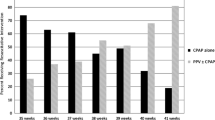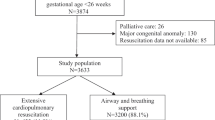Abstract
Objective:
Evaluate the need for resuscitative procedures at birth, in late prematures.
Study Design:
This prospective cohort study enrolled all liveborn infants from 1 to 30 September 2003, with 34 to 41 weeks of gestation without congenital anomalies, born in 35 public hospitals of 20 Brazilian state capitals. Logistic regression analyzed variables associated with the need for bag and mask ventilation.
Result:
Of the 10 774 infants studied, 1054 were late preterms and 485 required resuscitative measures. Of the 1054, 338 (32%) received only free-flow oxygen, 143 (14%) were bag and mask ventilated, 27 (3%) were intubated and 10/27 received chest compressions and/or medications. Bag and mask ventilation in late preterms was associated with twin gestation, maternal hypertension, nonvertex presentation, cesarean delivery and lower gestational age.
Conclusion:
Improving control of maternal hypertension, prolonging gestation for 1 to 2 weeks and restricting operative deliveries could decrease the need of resuscitation of late preterms at birth.
This is a preview of subscription content, access via your institution
Access options
Subscribe to this journal
Receive 12 print issues and online access
$259.00 per year
only $21.58 per issue
Buy this article
- Purchase on Springer Link
- Instant access to full article PDF
Prices may be subject to local taxes which are calculated during checkout
Similar content being viewed by others
References
Escobar GJ, Clark RH, Greene JD . Short-term outcomes of infants born at 35 and 36 weeks gestation: we need to ask more. Semin Perinatol 2006; 30: 28–33.
Engle WA . A recommendation for the definition of ‘late preterm’ (near-term) and the birth weight-gestational age classification system. Semin Perinatol 2006; 30: 2–7.
Tomashek KM, Shapiro-Mendoza CK, Weiss J, Kotelchuck M, Barfield W, Evans S et al. Early discharge among late preterm and term newborns and risk of neonatal morbidity. Semin Perinatol 2006; 30: 61–68.
Davidoff MJ, Dias T, Damus K, Russell R, Bettegowda VR, Dolan S et al. Changes in the gestational age distribution among U.S. singleton births: impact on rates of late preterm birth, 1992 to 2002. Semin Perinatol 2006; 30: 8–15.
Joseph KS, Demissie K, Kramer MS . Obstetric intervention, stillbirth, and preterm birth. Semin Perinatol 2002; 26: 250–259.
Langhoff-Ross J, Kesmodel U, Jacobsson B, Rasmussen S, Vogel I . Spontaneous preterm delivery in primiparous women at low risk in Denmark: population-based study. BMJ 2006; 332: 937–939.
Brazil - Ministry of Health - DATASUS. [Health Information–Vital statistics–Mortality and born alive infants: born alive infants - since 1994]. Available at http://tabnet.datasus.gov.br/cgi/deftohtm.exe?sinasc/cnv/nvuf.def,(accessed February 10 2007).
Jain L, Raju TNK . Preface. Clin Perinatol 2006; 33: xv–xvi.
Dobak WJ, Gardner MO . Late preterm gestation: physiology of labor and implications for delivery. Clin Perinatol 2006; 33: 765–776.
Silva AA, Barbieri MA, Gomes UA, Bettiol H . Trends in low birth weight: a comparison of two birth cohorts separated by a 15-year interval in Ribeirão Preto, Brazil. Bull World Health Organ 1998; 76: 73–84.
Brazil–Ministry of Health. [Secretary of Health Politics Technical Area on Women's Health. delivery, abortion and post-delivery period: humanized women assistance]. Ministério da Saúde: Brasília, 2001.
Kattwinkel J . Textbook of neonatal resuscitation. 4th edn. American Academy of Elk Grove Village: American Academy of Pediatrics/American Heart Association, 2000.
Ballard JL, Khoury JC, Wedig K, Wang L, Eilers-Walsman BL, Lipp R . New Ballard Score, expanded to include extremely premature infants. J Pediatr 1991; 119: 417–423.
Alexander GR, Himes JH, Kaufman RB, Mor J, Kogan M . A United States national reference for fetal growth. Obstet Gynecol 1996; 87: 163–168.
Raju TNK . Epidemiology of late preterm (near-term) births. Clin Perinatol 2006; 33: 751–763.
Sibai BM . Diagnosis and management of gestational hypertension and preeclampsia. Obstet Gynecol 2003; 102: 181–192.
Sibai BM . Preeclampsia as a cause of preterm and late preterm (near-term) births. Semin Perinatol 2006; 30: 16–19.
Barton JR, O'brien JM, Bergauer NK, Jacques DL, Sibai BM . Mild gestational hypertension remote from term: progression and outcome. Am J Obstet Gynecol 2001; 184: 979–983.
Villar J, Abalos E, Carroli G, Giordano D, Wojdyla D, Piaggio G et al. Heterogeneity of perinatal outcomes in the preterm delivery syndrome. Obstet Gynecol 2004; 104: 78–87.
Yang H, Kramer MS, Platt RW, Blondel B, Breart G, Morin I et al. How does early ultrasound scan estimation of gestational age lead to higher rates of preterm birth? Am J Obstet Gynecol 2002; 186: 433–437.
Barros FC, Victora CG, Barros AJD, Santos IS, Albernaz E, Matijasevich A et al. The challenge of reducing neonatal mortality in middle-income countries: findings from three Brazilian birth cohorts in 1982, 1993 and 2004. Lancet 2005; 365: 847–854.
Gomes UA, Silva AAM, Bettiol H, Barbieri MA . Risk factors for the increasing caesarean section rate in Southeast Brazil: a comparison of two birth cohorts, 1978–1979 and 1994. Int J Epidemiol 1999; 28: 687–694.
World Health Organization. Appropriate technology for birth. Lancet 1985; 2: 436–467.
Young D . New evidence on cesareans. Birth 2007; 34: 1–2.
Dudell GG, Jain L . Hypoxic respiratory failure in the late preterm infant. Clin Perinatol 2006; 33: 803–830.
Wang ML, Dorer DJ, Fleming MP, Catlin EA . Clinical outcomes of near-term infants. Pediatrics 2004; 114: 372–376.
Billiards SS, Pierson CR, Haynes RL, Folkerth RD, Kinney HC . Is the late preterm infant more vulnerable to gray matter injury than the term infant? Clin Perinatol 2006; 33: 915–933.
Kinney HC . The near-term (late preterm) human brain and risk for periventricular leucomalácia. Semin Perinatol 2006; 30: 81–88.
Acknowledgements
We thank all Brazilian Neonatal Resuscitation Program Local Investigators who helped with data collection; the Brazilian Society of Pediatrics Foundation who helped to support the study; and Adriana Sanudo for the statistical analysis.
Author information
Authors and Affiliations
Corresponding author
Additional information
Statistical consultant: Adriana Sanudo, former consultant at the Federal University of São Paulo.
Conflict of interest
The authors declare that they do not have any relationship with other people or organizations that could inappropriately influence this work.
Rights and permissions
About this article
Cite this article
de Almeida, M., Guinsburg, R., da Costa, J. et al. Resuscitative procedures at birth in late preterm infants. J Perinatol 27, 761–765 (2007). https://doi.org/10.1038/sj.jp.7211850
Received:
Revised:
Accepted:
Published:
Issue Date:
DOI: https://doi.org/10.1038/sj.jp.7211850
Keywords
This article is cited by
-
Neonatal Resuscitation in Delivery Room: Current Trends and Guidelines in 2022
Current Anesthesiology Reports (2023)
-
Oxygen saturation and heart rate in healthy term and late preterm infants with delayed cord clamping
Pediatric Research (2022)
-
A clinical scoring system to predict the need for extensive resuscitation at birth in very low birth weight infants
BMC Pediatrics (2019)
-
The transition from intra to extra-uterine life in late preterm infant: a single-center study
Italian Journal of Pediatrics (2016)
-
Intensity of delivery room resuscitation and neonatal outcomes in infants born at 33 to 36 weeks’ gestation
Journal of Perinatology (2016)



